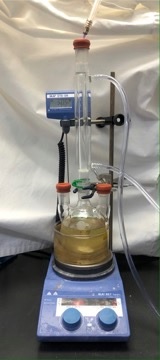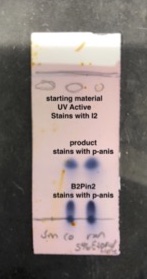Org. Synth. 2022, 99, 15-28
DOI: 10.15227/orgsyn.099.0015
Synthesis of Alkylboronic Esters from Alkyl Iodides
Submitted by Qianyi Liu, Hao Liang, Shangyong Zhou, Lei Zhang, Jianxin Yang, Yunxing Yin, Yang Yang, Di Qiu and Fanyang Mo
1,*Checked by Jordan Thompson and Sarah Reisman
1. Procedure (Note 1)
A. 4,4,5,5-Tetramethyl-2-octyl-1,3,2-dioxaborolane (3). A 1-L three-necked round-bottomed flask equipped with a 6-cm rod-shaped Teflon-coated magnetic stir bar is charged with bis(pinacolato)diboron (211 g, 833 mmol, 4.0 equiv) (Note 2). To the flask, MeOH (420 mL) and H2O (4.2 mL) (Note 3) are added using glass graduated cylinders successively, followed by 1-iodooctane (50.0 g, 208 mmol, 1.0 equiv, 37.8 mL) (Note 4) via syringe. The mixture is stirred for 1 min under air at ambient temperature to distribute 1-iodooctane evenly throughout the solution prior to addition of base. To this mixture, t-BuOLi (33.3 g, 416 mmol, 2.0 equiv) (Note 5) is added portion-wise under ambient atmosphere. The flask is fitted with a water-cooled reflux condenser and clamped above an oil bath on a hot plate/stirrer. Both of the side necks and the reflux condenser are sealed with rubber septa and an N2 inlet connected to a Schlenk line by a needle adaptor is inserted in the reflux condenser septum. The pressure inside the reaction system is reduced to <0.1 mmHg using a vacuum pump, and the atmosphere is refilled with N2 from the balloon. This vacuum-refill cycle is performed three additional times. The flask is lowered into a 50 °C oil bath and stirred for 56 h (Note 6) (Figure 1).

Figure 1. Reaction set-up (photo provided by checkers)
The solid reagents dissolve, which results in a colorless solution. A white solid precipitates after 2-3 h during stirring, and the conversion is monitored by TLC (Note 7) (Figure 2). Upon completion, the reaction mixture is cooled to 26 °C and filtered using a Büchner funnel (Note 8). The filter cake is washed with n-hexane (20 mL) (Note 9), and the combined filtrate is transferred to a 2-L round-bottomed flask. The combined filtrate is concentrated on a rotary evaporator (bath temperature 35 °C, 40 mmHg) to afford a white residue. To the residue in the 2-L round-bottomed flask, n-heptane (400 mL) is added. The resulting mixture is stirred at 26 °C for 10 min and filtered. The filtrate is transferred to a 1-L round-bottomed flask charged with a 2.5-cm rod-shaped stir bar and cooled to -50 °C in a dry ice-ethanol bath (Note 10). The solution is stirred for another 10 min and filtered. The filtrate is transferred to another 1-L round-bottomed flask and concentrated on a rotary evaporator (bath temperature 35 °C, 40 mmHg).

Figure 2. Thin Layer Chromatography (TLC) analysis (photo provided by checkers)
The residue (approximately 80 g) is dissolved in petroleum ether (100 mL), and the solution is charged onto a column (diameter = 10 cm) of 750-g silica gel (Note 11) and eluted with petroleum ether to remove the remaining starting material, which requires approximately 1000 mL of solvent. At this point petroleum ether:ethyl acetate (4:1) (1000 mL) is used to elute the product. The eluent is collected in a 2-L beaker until TLC analysis (Note 7) shows that no product (3) is still eluting from the silica gel. Approximately 2000 mL total of eluent is used in this step.
The eluent is concentrated by rotary evaporation at 35 °C (40 mmHg)., and eventually transferred into a 100-mL round-bottomed flask, using petroleum ether (20 mL) to wash the larger flasks. After concentration by rotary evaporation at 35 °C (40 mmHg) and further drying under high vacuum for 30 min at 26 °C (0.5 mmHg), product 3 (35 g, 70% isolated yield) is obtained as a colorless oil (Figure 3) (Notes 12, 13, and 14).2
Figure 3. Final purified product (photo provided by submitter)
2. Notes
1. Prior to performing each reaction, a thorough hazard analysis and risk assessment should be carried out with regard to each chemical substance and experimental operation on the scale planned and in the context of the laboratory where the procedures will be carried out. Guidelines for carrying out risk assessments and for analyzing the hazards associated with chemicals can be found in references such as Chapter 4 of "Prudent Practices in the Laboratory" (The National Academies Press, Washington, D.C., 2011; the full text can be accessed free of charge at
https://www.nap.edu/catalog/12654/prudent-practices-in-the-laboratory-handling-and-management-of-chemical. See also "Identifying and Evaluating Hazards in Research Laboratories" (American Chemical Society, 2015) which is available
via the associated website "Hazard Assessment in Research Laboratories" at
https://www.acs.org/content/acs/en/about/governance/committees/chemicalsafety/hazard-assessment.html. In the case of this procedure, the risk assessment should include (but not necessarily be limited to) an evaluation of the potential hazards associated with
diboron pinacol ester,
1-iodooctane,
lithium tert-butoxide,
methanol, dry ice,
ethanol, petroleum ether,
ethyl acetate,
2,3,5,6-tetrachloro-nitrobenzene, and silica gel.
2.
Bis(pinacolato)diboron (
B2pin2) was purchased by the submitters from Allychem Co., Ltd., Dalian, China, and was used as received. The checkers purchased
Bis(pinacolato)diboron (
B2pin2) (>98%) from Frontier Scientific and used the material as received.
3.
MeOH (AR) is obtained from KAISHILI Co., Ltd., Tianjin, China, and is used as received. The reaction is not sensitive to water. The checkers used
methanol (≥99.8%) purchased from Fisher Scientific.
4.
1-Iodooctane was purchased by the submitters from ENERGY Chemical Co., Ltd. and used as received. The checkers purchased
1-iodooctane (>97%) from VWR and used the material as received.
5.
t-BuOLi was purchased by the submitters from Bidepharm Co., Ltd., Shanghai, China, and was used as received. The checkers purchased
t-BuOLi (>99%) from Alfa Aesar and used the material as received.
t-BuOLi is very light and will disperse in the air when weighing it. To avoid inhalation, it is advisable to add it to a tared vessel in the hood.
6. An oil bath is used for the reaction. No gas evolution or solvent at reflux is observed.
7. TLC analysis is performed on silica gel plates (0.15-0.2 mm, glass backed, purchased from Dexin Corporation in Yantai, China) with petroleum ether (bp 40-60 °C)/
ethyl acetate (19:1) as eluent. The product (R
f = 0.37) can be detected by staining with
p-anisaldehyde, and the starting material can be observed under UV lamp (254 nm) or stained with I
2. Petroleum ether and
ethyl acetate are purchased from FUCHEN Chemical Reagent Co., Ltd, Tianjin, China, and are used as received. The checkers used petroleum ether (≥98.5%) and
ethyl acetate (≥99.5%), both purchased from Fisher Scientific.
8. Büchner funnels (10 cm diameter) are used for all filtration steps. Medium speed filter papers are used.
9.
n-Hexane is purchased from FUCHEN Chemical Reagent Co., Ltd, Tianjin, China, and used as received. The checkers used
n-hexane (≥99.5%) purchased from Fisher Scientific.
10. The filtrate is cooled and stirred at -50 °C in dry ice-
ethanol bath. The main component of the filter cake is
B2pin2 in this step.
11. 100-200 Mesh silica gel (Anhui, China) is employed. The residue (approximately 80 g) is dissolved in petroleum ether (bp 40-60 °C, 100 mL), and the solution is charged onto the column. The flow rate of the column is ~ 50 mL/min.
12. Characterization data of
3:
4,4,5,5-tetramethyl-2-octyl-1,3,2-dioxaborolane, colorless liquid; R
f = 0.37 (petroleum ether-
ethyl acetate, 19:1);
1H NMR
pdf (500 MHz, CDCl
3) δ: 0.77 (t,
J = 7.8 Hz, 2H), 0.88 (t,
J = 6.9 Hz, 3H), 1.25 (s, 12 H), 1.25-1.30 (m, 10H), 1.37-1.42 (m, 2H).
13C NMR
pdf (126 MHz, CDCl
3) δ: 14.1, 22.7, 24.0, 24.8, 29.3, 29.4, 31.9, 32.4, 82.8.
11B NMR
pdf (128 MHz, CDCl
3) δ: 34.64 (s). IR (neat): 2960 (s), 1465(s), 1378 (s), 1319 (s), 1214 (s), 1147 (s), 968 (s), 847 (s) cm
-1. HRMS [M
•+] calcd for C
14H
29BO
2 •+: 240.22551. Found: [M
•+]: 240.22563.
13. Analysis by qNMR
pdf, performed with
2,3,5,6-tetrachloro-nitrobenzene (Millipore Sigma, >99%) as an internal standard, indicated that the purity of the product was 98%.
14. When the reaction was performed at one-half scale, 17.6 g (70%) of the product was obtained.
Working with Hazardous Chemicals
The procedures in
Organic Syntheses are intended for use only by persons with proper training in experimental organic chemistry. All hazardous materials should be handled using the standard procedures for work with chemicals described in references such as "Prudent Practices in the Laboratory" (The National Academies Press, Washington, D.C., 2011; the full text can be accessed free of charge at
http://www.nap.edu/catalog.php?record_id=12654). All chemical waste should be disposed of in accordance with local regulations. For general guidelines for the management of chemical waste, see Chapter 8 of Prudent Practices.
In some articles in Organic Syntheses, chemical-specific hazards are highlighted in red "Caution Notes" within a procedure. It is important to recognize that the absence of a caution note does not imply that no significant hazards are associated with the chemicals involved in that procedure. Prior to performing a reaction, a thorough risk assessment should be carried out that includes a review of the potential hazards associated with each chemical and experimental operation on the scale that is planned for the procedure. Guidelines for carrying out a risk assessment and for analyzing the hazards associated with chemicals can be found in Chapter 4 of Prudent Practices.
The procedures described in Organic Syntheses are provided as published and are conducted at one's own risk. Organic Syntheses, Inc., its Editors, and its Board of Directors do not warrant or guarantee the safety of individuals using these procedures and hereby disclaim any liability for any injuries or damages claimed to have resulted from or related in any way to the procedures herein.
3. Discussion
Alkylboronic acids and esters are versatile building blocks in transition-metal-catalyzed cross-coupling reactions
3 and key intermediates in functional group interconversions.
4 Conventional methods to prepare alkylboronates include the electrophilic borylation of organolithium reagents
5 or Grignard reagents,
6 transition-metal-catalyzed hydroboration of olefins,
7 and transition-metal-catalyzed C―H borylation of hydrocarbons.
8 In recent years, transition-metal-free borylation of alkyl halides has emerged as a new approach for the preparation of alkylboronates.
9 In 2010, Wang reported the efficient direct conversion of anilines into aryl pinacol boronic esters
via a diazonium salt intermediate,
10 which is pioneering work on borylation based on a radical mechanism. Subsequently, numerous transition-metal-free borylation protocols have been developed.
11 However, the direct borylation of alkyl substrates without preliminary activation remains underdeveloped. Studer
12 and Jiao
13 have reported the direct borylation of alkyl substrates under photochemical conditions. In this context, we investigated and developed the direct transition-metal-free borylation of alkyl halides without the use of photochemical conditions.
2 This synthetic approach provides an operationally simple, transition-metal-free and irradiation-free protocol for the borylation of readily avalable alkyl iodide and bromide substrates. Furthermore, this transition-metal-free borylation occurs under mild conditions and tolerates a broad range of functional groups (Figure 4). Under these conditions, a diverse range of primary and secondary alkyl halides could be effectively transformed to the corresponding alkylboronates in good to excellent yield.
The borylation of alkyl halides proceeds via a radical mechanism. As the alkyl radical could also be reduced by methanol, a high concentration of free diboron is needed to increase the yield of borylation product. If less B2pin2 is used, the yield of borylation product will decrease resulting from the increase of reduction product. For a 0.5 mmol scale reaction, 3 equiv of B2pin2 and 1.5 equiv of t-BuOLi are sufficient; however, for large-scale preparations 4 equiv of B2pin2 and 2 equiv of t-BuOLi are required. In a small-scale reaction, the reaction system appears to be uniform and proceeds rapidly. In contrast, large-scale reactions involve a solid phase that may result in non-uniform temperature in different regions of the reaction system. In addition, concentration of different reagents in the solution may be difficult to determine, i.e., the concentration of diboron compound. Therefore, a higher concentration of reagents is needed to increase the conversion and borylation yield. In addition, a 50 g scale reaction requires the removal of the excess B2pin2 and other byproducts via filtration before purification on column chromatography, which results in the loss of a certain amount of the product and lower isolated yield.
Figure 4. Substrate Scope of Borylation of Alkyl Iodidesa
Appendix
Chemical Abstracts Nomenclature (Registry Number)
4,4,4',4',5,5,5',5'-Octamethyl-2,2'-bi(1,3,2-dioxaborolane): diboron pinacol ester; (73183-34-3)
1-Iodooctane; (629-27-6)
Lithium tert-butoxide; (1907-33-1)
Methanol; (67-56-1)
4,4,5,5-Tetramethyl-2-octyl-1,3,2-dioxaborolane; (3) (66217-56-9)

|
Dr. Qianyi Liu was born in Shandong province of China. He received his B.S. degree from Peking University in 2015. He obtained his Ph. D in 2020 under the supervision of Prof. Fanyang Mo. He now works as a Boya post-doctoral fellow in Prof. Rong Zhu's laboratory at College of Chemistry in Peking University. |

|
Hao Liang was born in February 1991 in Tai'an of Shandong province. He has received his B.S. degree from Tianjin University in 2012. |

|
Shangyong Zhou was born in November 1989 in Tai'an of Shandong province. He has received his Master's degree from Tianjin Normal University in 2015. Now he is a team leader in WuXi AppTec. |

|
Lei Zhang was born in 1993 in Henan province of China. He obtained his B. Eng. degree from Beijing Institute of Technology in 2016. In the same year, he moved to Peking University and started his Ph.D. study under the supervision of Prof. Fanyang Mo. |

|
Jianxin Yang was born in April 1980 in Jiangxi province of China. He has received his B.S. and M.S. degree from Jilin University in 2002 and 2005. Now he is a Director II in WuXi AppTec. |

|
Yunxing Yin was born in Hubei province of China. He has received his B.S. degree from Three Gorges University in 2000. Now he is a VP of chemistry in WuXi AppTec. |

|
Yang Yang received his B.Sc. degree in Chemistry from Peking University in 2011. He carried out graduate research under the guidance of Prof. Stephen Buchwald at the Massachusetts Institute of Technology, studying copper-catalyzed asymmetric hydrofunctionalization of simple olefins. He then performed postdoctoral research in the laboratory of Prof. Frances Arnold at the California Institute of Technology, where he evolved cytochrome P450 enzymes for enantioselective C(sp3)-H amination reactions. In 2020, he became an Assistant Professor in the Department of Chemistry and Biochemistry at the University of California Santa Barbara. |

|
Di Qiu was born in Tianjin, China, in 1987. He received his B.S. degree from Peking University in 2010. He continued his graduate study in Prof. Jianbo Wang's laboratory and obtained his Ph.D. in 2015. In the same year, he joined in Tianjin Normal University as an assistant professor. His research interests lie in aromatic C−P bond formation and functional group transformations in aromatic compounds. |

|
Fanyang Mo was born in Liaoyang city of Liaoning Province in 1982. He obtained his undergraduate degree and Master's degree in applied chemistry in 2004 and 2006 at Beijing Institute of Technology under the supervision of Professor Zhiming Zhou. He then moved to Peking University where he studied the synthetic applications of diazo compounds and aryldiazonium salts transformations under the supervision of Prof. Jianbo Wang. After receiving his Ph.D. in 2010, he went to the US and worked with Professor Qinghai Zhang at The Scripps Research Institute and Professor Guangbin Dong at The University of Texas at Austin from 2010 to 2015. He joined Peking University as an Assistant Professor in April 2015. His research interests are photo/electro-driven organic synthesis and the modification of semiconductor oxides for energy application, molecular electronics. Now and in the future, Dr. Mo and his group are dedicated in using artificial intelligence and robotics to improve the production efficiency of scientific knowledge, accelerate the development of organic chemistry, and improve the basic role of synthetic chemistry in material preparation and drug development. |

|
Jordan Thompson is a second-year graduate student in Professor Sarah Reisman's laboratory. He is interested in the total synthesis of complex natural products and completed his undergraduate studies at UC Berkeley under the guidance of Professor Tom Maimone. |
Copyright © 1921-, Organic Syntheses, Inc. All Rights Reserved